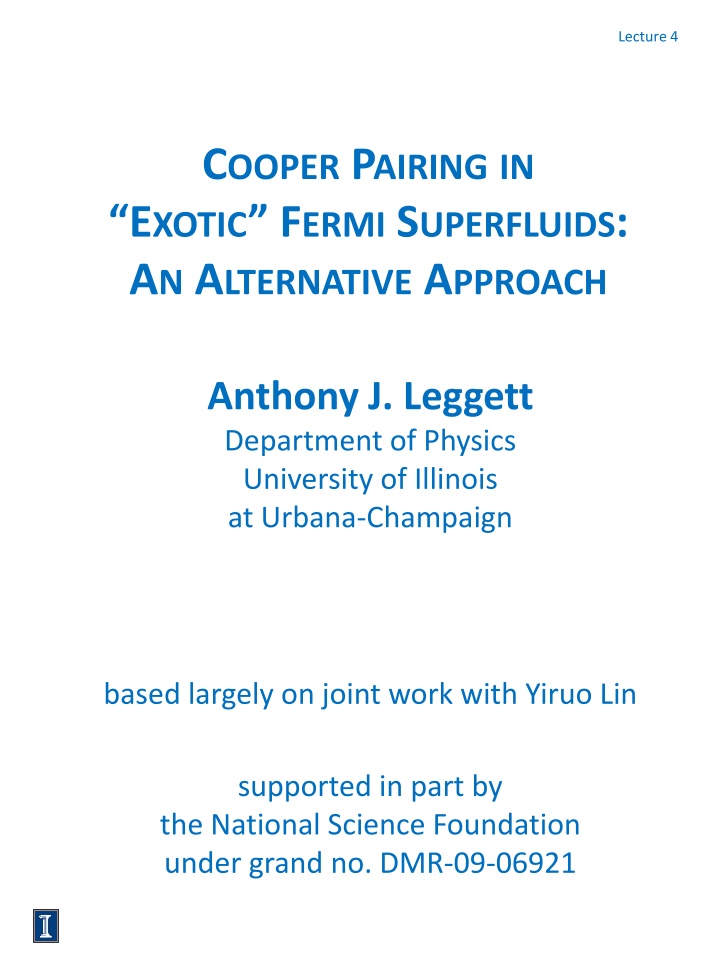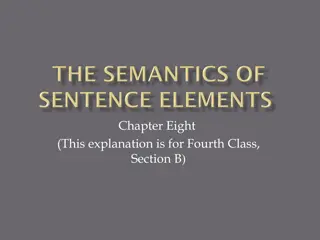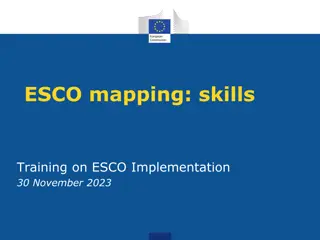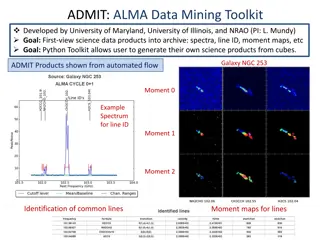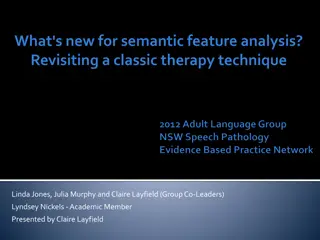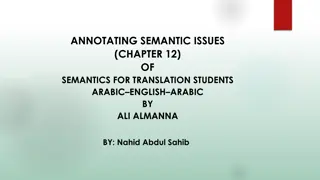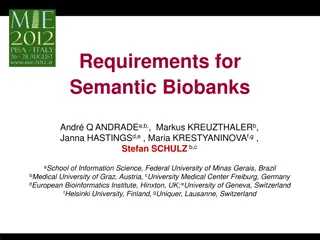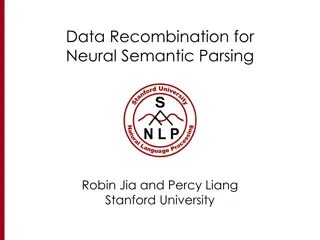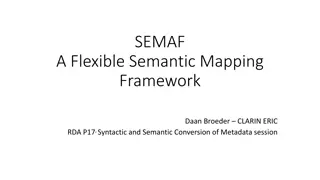Mapping & Transforming Data for Semantic Integration: X3ML Toolkit
Syntactic and semantic conversion of metadata discussed at RDA 17th Plenary Meeting in Edinburgh. Institutions like galleries, libraries, archives, and museums curate different collections leading to challenging metadata integration requirements. Unified data sources are essential for research progress and information retrieval. The X3ML toolkit plays a crucial role in data aggregation and integration.
Download Presentation

Please find below an Image/Link to download the presentation.
The content on the website is provided AS IS for your information and personal use only. It may not be sold, licensed, or shared on other websites without obtaining consent from the author.If you encounter any issues during the download, it is possible that the publisher has removed the file from their server.
You are allowed to download the files provided on this website for personal or commercial use, subject to the condition that they are used lawfully. All files are the property of their respective owners.
The content on the website is provided AS IS for your information and personal use only. It may not be sold, licensed, or shared on other websites without obtaining consent from the author.
E N D
Presentation Transcript
Lecture 4 COOPER PAIRINGIN EXOTIC FERMI SUPERFLUIDS: AN ALTERNATIVE APPROACH Anthony J. Leggett Department of Physics University of Illinois at Urbana-Champaign based largely on joint work with Yiruo Lin supported in part by the National Science Foundation under grand no. DMR-09-06921
AC 4.1 Why are MF s anyons? Let s number the vortices 1, , 2n in an arbitrary way, and consider the result of exchanging the vortices i and i + 1. Ivanov s* argt.: Vortex ( iT ) i sees no change in phase of superconducting order parameter (r), vortex i + 1 sees a change of 2 . Hence : i T + i i 1 + i 1 i for j + j i i , 1 j note satisfies braid-group CR s. *PRL86, 268 (2001).
AC 4.2 Why are MF s anyons? (cont) ( ) T ( ) = + i = + + i 4 exp 1 2 1 So: i 1 i 1 i (defined so that{ g } = t( Ti){g } t-1( Ti) Consider case of 2 fermions, then the Hilbert space is 2D, corresponding to no fermions present and a single Dirac fermion, a : this fermion is delocalized between the two vortices. In this basis we have ( ) = 0 i ( ) 0 0 1 T 4 4 exp i ( exp i 1 for convenience) z 1 0 In words: exchanging the 2 vortices leaves state unchanged if no fermion present, changes phase by /2 if one present.
AC 4.3 Why are MF s anyons? (cont.) qubit 1 qubit 2 The case of 2 fermions, paired as 1 2, 3 4: ( ) ( ) 3 T T = 4 (1) z exp i 1 = 4 (2) z exp i ( ) T 2 but, what if we exchange 2 and 3: what is ? The form of (2 3) in the 4D Hilbert space: ( ) T 2 ( ) + 2 1 a a , i a a Since 3 2 2 1 ( ) 2 T note suffixes refer to qubits not vortices! = 3 2 + = 4 exp ( )( ) = 3 2 + + 2 1 1 2 1 2 (1 ) 1 i a a a a 2 1 ( ) = + y (1) (2) x 1 2 1 2 1 1 0 0 0 1 i 0 i 1 0 i 0 0 1 i 0 entangling!
AC 4.4 Why are MF s anyons? (cont.) However, this is a bit misleading, because all operations preserve number parity of state. (as do all real-life physical operations). Hence, preferable tofix the parity and regard 4-anyon system as single qubit associated with e.g. anyons 1 and 2: e.g. for odd N = = 0 no MF on (1,2), MF on (3,4) 1 MF on (1,2), no MF on (3,4) and for even N, = = 0 no MF's at all 1 MF's on all 4 vortices With the above convention (for odd N), ( ) 0 ( MF 12 ) ,0 , 1 0 ,( MF 34 ) 34 12 and we can verify that in both even and odd subspaces, = 3 2 i x .
AC 4.5 Why are MF s anyons? (cont.) The braiding matrices are (all arb. overall abelian phase factors) = 0 1 and 1 2 1 i R R = , , 12 34 1 0 i 0 1 i 0 4 = = R exp -i 23 x i exp i 4, i.e. multiplying R12, R34 by R12= R34 4 sz, R23= exp -ip -1= exp ip 4 sx The R s so defined trivially satisfy the first braid- group relation, , i R R = 0 for i j 2 R R + j i i i , 1 Do they satisfy the second relation, i i RR R i R RR = ? + + + 1 i 1 i i 1 Yes! ( ) = = 1 2 12 23 12 R R R 23 12 23 R R R z x
AC 4.6 2 qubits The simplest way of generating 2 qubits is to use 2n = 6 anyons, and associate qubit 1 with the states of the anyon pair (1,2) and qubit 2 with pair (5,6). For definite, e.g. odd, parity the resulting Hilbert space is 2n-1 = 4 dim l, as it should be. The pair (3,4) is used, as before, to soak up any remaining parity. So, e.g., we can take the 4 states to be, for odd N, (3,4) (1,2) (5,6) 1 2 00 01 0,1,0 , 10 1,0,0 , 1 2 0,0,1 , 11 1,1,1 1 2 1 2 R ? What is the effect of braids + i i , 1 As before, R R = = 4 4 (1) z (2) z exp i and sim. exp i 12 56
AC 4.7 2 qubits Moreover, just as before exp-i R R = = 4 4 (1) x (2) x and sim. exp i 23 45 R But what is the effect of ? Acting on the pseudoqubit (3,4) = 0 i Hence, 34 R ( abelian phase) 34 1 0 R R = = 100 100 , 001 001 , 34 R 34 R = = but 010 i 010 , 111 i 111 . 34 34 ( ) 100 1 2 10 Thus in 2-qubit basis , etc. 2-particle entangling gate! 2 ( ) R = 1 z + exp i 1 34 z 2 1 0 0 0 0 1 0 0 0 0 0 0 0 1 0 i 6 anyons permit large set (but not complete one) of 1- and 2-qubit operations.
AC 4.8 1. A cautionary tale (combination of SBU(1)S and Berry-phase arguments) Consider a simple neutral s-wave BCS superfluid in a large ? ? annulus. We construct a Zeeman trap s.t. the potential is ? ? = ???? ? with min. at ??: adjust parameters so that there is exactly one bound state of appropriate spin in trap. Width of trap + hence of state ?., shallow so ?~ . ?? B ? ? The 2? particle ?? 2? is clear: completely Cooper-paired state with ??? at rest, effect of trap is ~ ??/ 2, ??= ? (so if trap is moved once around annulus, ??= ?). In PNC approach, 2? is still defined mod 2, so same conclusion.
AC 4.9 Now consider odd-parity GS. Presumably, CP s still at rest, one qp in trap., i.e. in PNC approach, ???= ? ? ? ? + ? ? ? (?) ??| +| ???? ???? ?? In PC approach, (at first sight!) 2?+1= ? ? ? ? + ? ? ? ? ? ??| 2? In either case, relation to 2?-particle CS there is an equal admixture of extra particle and extra hole in the trap region, so in that region there is an extra spin density but no extra particle density. There is also no current associated with the extra qp, hence no angular momentum and thus the Berry phase for encirclement by the trap is again zero. Now suppose the condensate is moving, with the minimum velocity /2? (not /?!) (as in case of Abrikosov vortex, ? ? ?). Again, we move the trap once around the annulus, adiabatically. The crucial question: What is ??? (relative to the 2? particle circulating state: when presumably ? = 2??~?) (?,?, ill-defined, none of the above...) (Note: in principle, experimentally meaningful question!)
AC 4.10 A. Approach based on BdG equations For the s-wave case and a spin- qp, BDG equations read 2 2??2+ V ? (etc.) ? ? + ? ? ? = ?? ? where v ? v ? ?? and ? exp??. For the moment, assume dependence on ? ??is real , i.e. ? ?:?? = ? ??? ? ??,? real (etc.) ( : not obvious!). Then this dependence cannot contribute to ?? problem is exactly analogous to the textbook spin -1/2 problem with ? ? ? ?? ? ?? ? ?? Moreover, for a bound state ?2= ?2 equivalent to field in xy-plane Hence by this analogy, ??=? (na ve BdG argument with SBU(1)S) Note this also follows from the fact that ? ?= ?= 1 ?? =1 22 ?+ 1 = ? + 1/2 2 ?+ ? =1 so , n integer
AC 4.11 B. Approach assuming PC: Now, what if we try to modify this argument for the PC case? We now have += ? ? ? ? + ? ? ? ? ? ?? so while we still have ? ?= ?= 1, we now have ?? =1 2 ?+ ?+ ? =1 22 ?+ 2 = ?+ 1 = integer. Hence (mod 2?) ??= 0 (na ve argument, particle-conserving) However, let s revisit the dependence of ? ? ?? (etc.) on ? ??. Does this contribute to the e.v. of the angular momentum ?? (i.e. is ? ? ? ?? ? ??? ? ???? 0?) In words: when condensate is moving, is qp dragged with it or stationary with respect to the walls? -- a surprisingly tricky question! (For stationary condensate, in complete absence of normal reflection, GS is 2-fold degenerate). Almost certainly qp dragged partially , but not enough to give back BSBU(1)S BdG result. amount depends on specifics of potential, etc.
AC 4.12 Back to the Ivanov problem According to Ivanov, if we have paired vortices ? and ? + 1 and we interchange them, then if no Majoranas, ??= 0 if two Majoranas, ??= ?/2 It is more convenient to consider encirclement of ? at ? = 0 by ? + 1. So in our language, Ivanov s prediction for this operation is 2 even-number-parity states: ??= 0 ?? 1 odd-number-parity states: ??= ? Can we recover this prediction? We use the fundamental result that since ??? = ??? ??, ??= 2? ??.
AC 4.13 (a) In the PNC approach (taken by Ivanov) for the odd- number-parity state ??=1 4 ?1+ ?2+ ?1+ ?2 ( ?1 ang. moment of particle component of Majorana in vortex 1, etc.) ? = ?1? , ?1= ?1 (etc.) ?? = However, since ?1 0. Thus, within PNC approach we have for the odd-number- parity state (mod. 2 ) ??= 0different from Ivanov s result! (b) In the PC approach, the ? component of the Majorana is associated with creation of one extra Cooper pair. Hence ??=1 4 ?1+ ?1+ ?+ ?2+ ?2+ ? =1 2 ? where ? is the total angular momentum associated with the addition of an extra Cooper pair. This is just 1+ 2+ int vortex 1 votex 2 relative a.m. And since int= 1, and 1+ 2= 0 or 2, ? is always an add integer and thus ??= recovering Ivanov s result : when we let (say) ?1 ?1 and thus add a Cooper pair, does that pair feel the effects of the angular momentum of the distant vortex 2?
